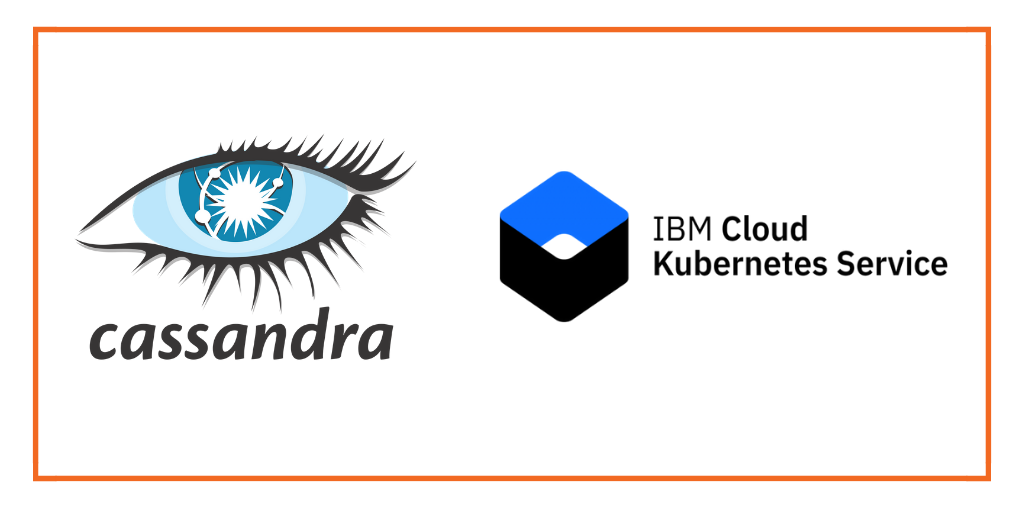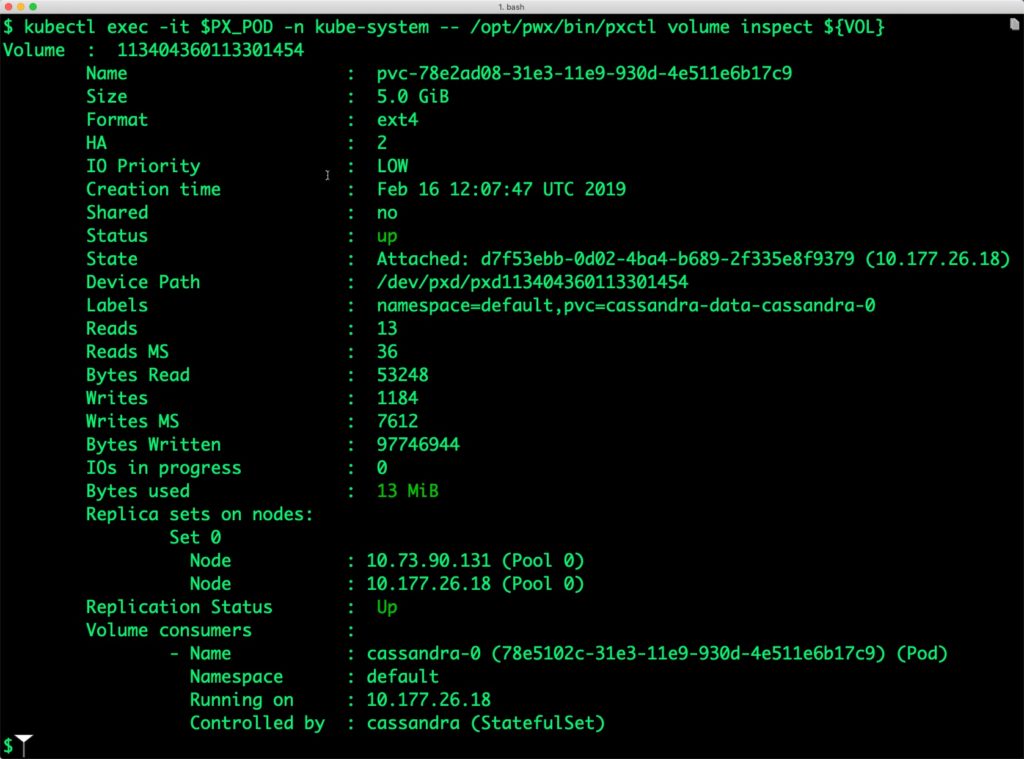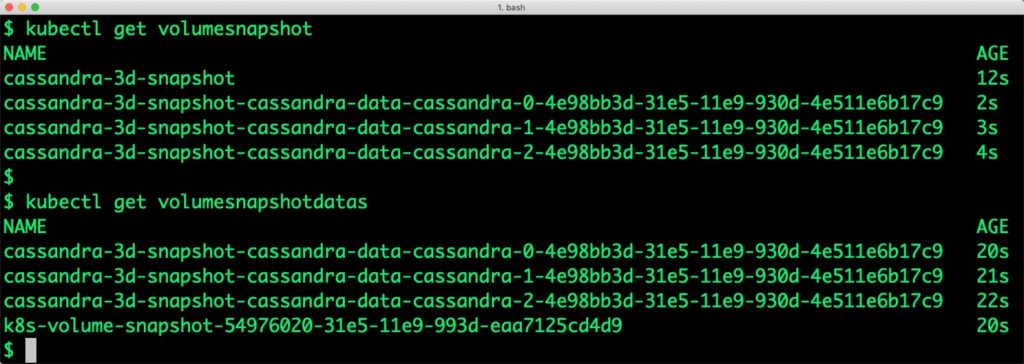Portworx Hands-on Labs Register Now

This post is part of our ongoing series on running Cassandra on Kubernetes. We’ve published a number of articles about running Cassandra on Kubernetes for specific platforms and for specific use cases. If you are looking for a specific Kubernetes platform, check out these related articles.
Running HA Cassandra on Amazon Elastic Container Service for Kubernetes (EKS)
Running HA Cassandra on Google Kubernetes Engine (GKE)
Running HA Cassandra on Red Hat OpenShift
Running HA Cassandra on Azure Kubernetes Service (AKS)
Running HA Cassandra on Rancher Kubernetes Engine (RKE)
Running HA Cassandra on IBM Cloud Private
And now, onto the post…
IBM Cloud Kubernetes Service is a managed Kubernetes offering running in IBM Cloud. It is designed to deliver powerful tools, intuitive user experience, and built-in security for rapid delivery of applications that can be bound to cloud services related to IBM Watson, IoT, DevOps and data analytics. As a CNCF certified Kubernetes provider, IBM Cloud Kubernetes Service provides intelligent scheduling, self-healing, horizontal scaling, service discovery and load balancing, automated rollouts and rollbacks, and secret and configuration management. The service also has advanced capabilities around simplified cluster management, container security, and isolation policies, the ability to design a cluster with a custom configuration and integrated operational tools for consistency in deployment.
Portworx is a cloud native storage platform to run persistent workloads deployed on a variety of orchestration engines including Kubernetes. With Portworx, customers can manage the database of their choice on any infrastructure using any container scheduler. It provides a single data management layer for all stateful services, no matter where they run.
This tutorial is a walk-through of the steps involved in deploying and managing a highly available Cassandra cluster on IBM Cloud Kubernetes Service (IKS).
In summary, to run HA Cassandra cluster on IKS you need to:
- Launch an IKS cluster running on bare metal servers with software-defined storage (SDS)
- Install cloud native storage solution like Portworx as a daemon set on IKS
- Create a storage class defining your storage requirements like replication factor, snapshot policy, and performance profile
- Deploy Cassandra as a StatefulSet on Kubernetes
- Test failover by killing or cordoning nodes in your cluster
- Optional – Take an app consistent snapshot of Cassandra
- Optional – Bootstrap a new Cassandra cluster from snapshot backup
Launching an IKS Cluster
For running stateful workloads in a production environment backed by Portworx, it is highly recommended to launch an IKS cluster based on bare metal servers and software-defined storage. The minimum requirements of a worker node to successfully run Portworx include:
- 4 CPU cores
- 4GB memory
- 128GB of raw unformatted storage
- 10Gbps network speed
For details on launching a Kubernetes cluster with bare metal worker nodes, please refer to the documentation of IBM Cloud Kubernetes Service.
We are using an IKS cluster with 4 nodes out of which 3 nodes are running bare metal servers with SDS based on the instance type ms2c.4x32.1.9tb.ssd.encrypted. Only these machines that meet the prerequisite would be used by Portworx.

When we filter the nodes based on the label, we see the below nodes:
$ kubectl get nodes -l beta.kubernetes.io/instance-type=ms2c.4x32.1.9tb.ssd.encrypted NAME STATUS ROLES AGE VERSION 10.177.26.18 Ready <none> 4d7h v1.13.2+IKS 10.185.22.28 Ready <none> 4d7h v1.13.2+IKS 10.73.90.131 Ready <none> 4d3h v1.13.2+IKS
To exclude nodes that don’t meet Portworx prerequisites, you can apply a label to skip the installation of Portworx. For example, the below command applies a label on the node with name 10.185.22.14 which doesn’t run on a bare metal server.
$ kubectl label nodes 10.185.22.14 px/enabled=false --overwrite
Installing Portworx in IKS
Installing Portworx on IKS is not very different from installing it on any other Kubernetes cluster. It is recommended that you create an etcd instance through Compose for etcd. You can use the Helm Chart to install Portworx cluster in IKS. Portworx documentation for IKS has the prerequisites and instructions to install and configure Portworx, STORK, and other components.
At the end of the installation, we will have Portworx Daemonset running on the nodes excluding those that are filtered out in the previous step.

Once the IKS cluster is up and running, and Portworx is installed and configured, we will deploy a highly available Cassandra database cluster.
Creating a storage class for Cassandra
Once the IKS cluster is up and running, and Portworx is installed and configured, we will deploy a highly available Cassandra database.
Through storage class objects, an admin can define different classes of Portworx volumes that are offered in a cluster. These classes will be used during the dynamic provisioning of volumes. The storage class defines the replication factor, I/O profile (e.g., for a database or a CMS), and priority (e.g., SSD or HDD). These parameters impact the availability and throughput of workloads and can be specified for each volume. This is important because a production database will have different requirements than a development Jenkins cluster.
In this example, the storage class that we deploy has a replication factor of 3 with I/O profile set to “db,” and priority set to “high.” This means that the storage will be optimized for low latency database workloads like Cassandra and automatically placed on the highest performance storage available in the cluster.
$ cat > px-cassandra-sc.yaml << EOF kind: StorageClass apiVersion: storage.k8s.io/v1 metadata: name: px-storageclass provisioner: kubernetes.io/portworx-volume parameters: repl: "3" io_profile: "db_remote" priority_io: "high" fg: "true" EOF
Create the storage class and verify its available in the default namespace.
$ kubectl create -f px-cassandra-sc.yaml storageclass.storage.k8s.io/px-storageclass created $ kubectl get sc NAME PROVISIONER AGE default ibm.io/ibmc-file 8d ibmc-file-bronze (default) ibm.io/ibmc-file 8d ibmc-file-custom ibm.io/ibmc-file 8d ibmc-file-gold ibm.io/ibmc-file 8d ibmc-file-retain-bronze ibm.io/ibmc-file 8d ibmc-file-retain-custom ibm.io/ibmc-file 8d ibmc-file-retain-gold ibm.io/ibmc-file 8d ibmc-file-retain-silver ibm.io/ibmc-file 8d ibmc-file-silver ibm.io/ibmc-file 8d portworx-db-sc kubernetes.io/portworx-volume 19h portworx-db2-sc kubernetes.io/portworx-volume 19h portworx-null-sc kubernetes.io/portworx-volume 19h portworx-shared-sc kubernetes.io/portworx-volume 19h px-repl3-sc kubernetes.io/portworx-volume 41h px-storageclass kubernetes.io/portworx-volume 11s stork-snapshot-sc stork-snapshot 19h
Deploying Cassandra StatefulSet on IKS
Finally, let’s create a Cassandra cluster as a Kubernetes StatefulSet object. Like a Kubernetes deployment, a StatefulSet manages pods that are based on an identical container spec. Unlike a deployment, a StatefulSet maintains a sticky identity for each of their Pods. For more details on StatefulSets, refer to Kubernetes documentation.
A StatefulSet in Kubernetes requires a headless service to provide network identity to the pods it creates. The following command and the spec will help you create a headless service for your Cassandra installation.
$ cat > px-cassandra-svc.yaml << EOF
apiVersion: v1
kind: Service
metadata:
labels:
app: cassandra
name: cassandra
spec:
clusterIP: None
ports:
- port: 9042
selector:
app: cassandra
EOF
$ kubectl create -f px-cassandra-svc.yaml service/cassandra created
Now, let’s go ahead and create a StatefulSet running Cassandra cluster based on the below spec.
cat > px-cassandra-app.yaml << EOF
apiVersion: apps/v1
kind: StatefulSet
metadata:
name: cassandra
spec:
selector:
matchLabels:
app: cassandra
serviceName: cassandra
replicas: 3
template:
metadata:
labels:
app: cassandra
spec:
schedulerName: stork
containers:
- name: cassandra
image: cassandra:3
ports:
- containerPort: 7000
name: intra-node
- containerPort: 7001
name: tls-intra-node
- containerPort: 7199
name: jmx
- containerPort: 9042
name: cql
env:
- name: CASSANDRA_SEEDS
value: cassandra-0.cassandra.default.svc.cluster.local
- name: MAX_HEAP_SIZE
value: 512M
- name: HEAP_NEWSIZE
value: 512M
- name: CASSANDRA_CLUSTER_NAME
value: "Cassandra"
- name: CASSANDRA_DC
value: "DC1"
- name: CASSANDRA_RACK
value: "Rack1"
- name: CASSANDRA_AUTO_BOOTSTRAP
value: "false"
- name: CASSANDRA_ENDPOINT_SNITCH
value: GossipingPropertyFileSnitch
volumeMounts:
- name: cassandra-data
mountPath: /var/lib/cassandra
volumeClaimTemplates:
- metadata:
name: cassandra-data
annotations:
volume.beta.kubernetes.io/storage-class: px-storageclass
labels:
app: cassandra
spec:
accessModes: [ "ReadWriteOnce" ]
resources:
requests:
storage: 1Gi
EOF
$ kubectl apply -f px-cassandra-app.yaml statefulset.apps/cassandra created
Verify that all the pods are in the Running state before proceeding further.
$ kubectl get statefulset NAME DESIRED CURRENT AGE cassandra 3 2 45s
$ kubectl get pods NAME READY STATUS RESTARTS AGE cassandra-0 1/1 Running 0 30s cassandra-1 1/1 Running 0 21s cassandra-2 1/1 Running 0 11s

Let’s also check if persistent volume claims are bound to the volumes.
$ kubectl get pvc NAME STATUS VOLUME CAPACITY ACCESS MODES STORAGECLASS AGE cassandra-data-cassandra-0 Bound pvc-78e2ad08-31e3-11e9-930d-4e511e6b17c9 5Gi RWO px-storageclass 2m29s cassandra-data-cassandra-1 Bound pvc-7e41a4c6-31e3-11e9-930d-4e511e6b17c9 5Gi RWO px-storageclass 2m20s cassandra-data-cassandra-2 Bound pvc-840e19eb-31e3-11e9-930d-4e511e6b17c9 5Gi RWO px-storageclass 2m10s
Notice the naming convention followed by Kubernetes for the pods and volume claims. The arbitrary number attached to each object indicates the association of pods and volumes.
We can now inspect the Portworx volume associated with one of the Cassandra pod by accessing the pxctl tool.
$ VOL=`kubectl get pvc | grep cassandra-0 | awk '{print $3}'`
$ PX_POD=$(kubectl get pods -l name=portworx -n kube-system -o jsonpath='{.items[0].metadata.name}')
$ kubectl exec -it $PX_POD -n kube-system -- /opt/pwx/bin/pxctl volume inspect ${VOL}
Volume : 113404360113301454
Name : pvc-78e2ad08-31e3-11e9-930d-4e511e6b17c9
Size : 5.0 GiB
Format : ext4
HA : 2
IO Priority : LOW
Creation time : Feb 16 12:07:47 UTC 2019
Shared : no
Status : up
State : Attached: d7f53ebb-0d02-4ba4-b689-2f335e8f9379 (10.177.26.18)
Device Path : /dev/pxd/pxd113404360113301454
Labels : namespace=default,pvc=cassandra-data-cassandra-0
Reads : 13
Reads MS : 36
Bytes Read : 53248
Writes : 1184
Writes MS : 7612
Bytes Written : 97746944
IOs in progress : 0
Bytes used : 13 MiB
Replica sets on nodes:
Set 0
Node : 10.73.90.131 (Pool 0)
Node : 10.177.26.18 (Pool 0)
Replication Status : Up
Volume consumers :
- Name : cassandra-0 (78e5102c-31e3-11e9-930d-4e511e6b17c9) (Pod)
Namespace : default
Running on : 10.177.26.18
Controlled by : cassandra (StatefulSet)

The output from the above command confirms the creation of volumes that are backing Cassandra nodes.
We can also use Cassandra’s nodetool to check the status of the cluster.
$ kubectl exec cassandra-0 -- nodetool status Datacenter: DC1 =============== Status=Up/Down |/ State=Normal/Leaving/Joining/Moving -- Address Load Tokens Owns (effective) Host ID Rack UN 172.30.122.147 93.96 KiB 256 62.0% e271976b-ebc7-47a2-a715-e3c969c132f3 Rack1 UN 172.30.59.96 108.61 KiB 256 69.2% 52d484b9-50a2-401a-b481-b98e66388f86 Rack1 UN 172.30.59.97 177.35 KiB 256 68.7% 58190bc9-f5dc-49c9-abfb-49dacc83df96 Rack1

To get the pods and hosts associated with the Cassandra cluster, run the below command:
$ kubectl get pods -l app=cassandra -o json | jq '.items[] | {"name": .metadata.name,"hostname": .spec.nodeName, "hostIP": .status.hostIP, "PodIP": .status.podIP}'
{
"name": "cassandra-0",
"hostname": "10.177.26.18",
"hostIP": "10.177.26.18",
"PodIP": "172.30.59.96"
}
{
"name": "cassandra-1",
"hostname": "10.73.90.131",
"hostIP": "10.73.90.131",
"PodIP": "172.30.122.147"
}
{
"name": "cassandra-2",
"hostname": "10.177.26.18",
"hostIP": "10.177.26.18",
"PodIP": "172.30.59.97"
}
Failing over Cassandra pod on Kubernetes
Populating sample data
Let’s populate the database with some sample data by accessing the first node of the Cassandra cluster. We will do this by invoking Cassandra shell, cqlsh in one of the pods.
$ kubectl exec -it cassandra-0 -- cqlsh Connected to Cassandra at 127.0.0.1:9042. [cqlsh 5.0.1 | Cassandra 3.11.3 | CQL spec 3.4.4 | Native protocol v4] Use HELP for help. cqlsh>
Now that we are inside the shell, we can create a keyspace and populate it.
CREATE KEYSPACE classicmodels WITH REPLICATION = { 'class' : 'SimpleStrategy', 'replication_factor' : 3 };
CONSISTENCY QUORUM;
Consistency level set to QUORUM.
use classicmodels;
CREATE TABLE offices (officeCode text PRIMARY KEY, city text, phone text, addressLine1 text, addressLine2 text, state text, country text, postalCode text, territory text);
INSERT into offices(officeCode, city, phone, addressLine1, addressLine2, state, country ,postalCode, territory) values
('1','San Francisco','+1 650 219 4782','100 Market Street','Suite 300','CA','USA','94080','NA');
INSERT into offices(officeCode, city, phone, addressLine1, addressLine2, state, country ,postalCode, territory) values
('2','Boston','+1 215 837 0825','1550 Court Place','Suite 102','MA','USA','02107','NA');
INSERT into offices(officeCode, city, phone, addressLine1, addressLine2, state, country ,postalCode, territory) values
('3','NYC','+1 212 555 3000','523 East 53rd Street','apt. 5A','NY','USA','10022','NA');
INSERT into offices(officeCode, city, phone, addressLine1, addressLine2, state, country ,postalCode, territory) values
('4','Paris','+33 14 723 4404','43 Rue Jouffroy abbans', NULL ,NULL,'France','75017','EMEA');
INSERT into offices(officeCode, city, phone, addressLine1, addressLine2, state, country ,postalCode, territory) values
('5','Tokyo','+81 33 224 5000','4-1 Kioicho',NULL,'Chiyoda-Ku','Japan','102-8578','Japan');
INSERT into offices(officeCode, city, phone, addressLine1, addressLine2, state, country ,postalCode, territory) values
('6','Sydney','+61 2 9264 2451','5-11 Wentworth Avenue','Floor #2',NULL,'Australia','NSW 2010','APAC');
INSERT into offices(officeCode, city, phone, addressLine1, addressLine2, state, country ,postalCode, territory) values
('7','London','+44 20 7877 2041','25 Old Broad Street','Level 7',NULL,'UK','EC2N 1HN','EMEA');
INSERT into offices(officeCode, city, phone, addressLine1, addressLine2, state, country ,postalCode, territory) values
('8','Mumbai','+91 22 8765434','BKC','Building 2',NULL,'MH','400051','APAC');
Let’s verify that the data is populated.
SELECT * FROM classicmodels.offices;
officecode | addressline1 | addressline2 | city | country | phone | postalcode | state | territory
------------+------------------------+--------------+---------------+-----------+------------------+------------+------------+-----------
6 | 5-11 Wentworth Avenue | Floor #2 | Sydney | Australia | +61 2 9264 2451 | NSW 2010 | null | APAC
7 | 25 Old Broad Street | Level 7 | London | UK | +44 20 7877 2041 | EC2N 1HN | null | EMEA
4 | 43 Rue Jouffroy abbans | null | Paris | France | +33 14 723 4404 | 75017 | null | EMEA
3 | 523 East 53rd Street | apt. 5A | NYC | USA | +1 212 555 3000 | 10022 | NY | NA
5 | 4-1 Kioicho | null | Tokyo | Japan | +81 33 224 5000 | 102-8578 | Chiyoda-Ku | Japan
8 | BKC | Building 2 | Mumbai | MH | +91 22 8765434 | 400051 | null | APAC
2 | 1550 Court Place | Suite 102 | Boston | USA | +1 215 837 0825 | 02107 | MA | NA
1 | 100 Market Street | Suite 300 | San Francisco | USA | +1 650 219 4782 | 94080 | CA | NA
(8 rows)
cqlsh:classicmodels>

Exit from the client shell to return to the host.
You can run the select query by accessing cqlsh from any of the pods of the StatefulSet.
Run nodetool again to check the replication of the data. The below command shows that the hosts on which the row with officecode=6 is available.
$ kubectl exec -it cassandra-0 -- nodetool getendpoints classicmodels offices 6 172.30.122.147 172.30.59.97 172.30.59.96
Simulating node failure
Let’s get the node name where the first pod of Cassandra StatefulSet is running.
$ NODE=`kubectl get pods cassandra-0 -o json | jq -r .spec.nodeName`
Now, let’s simulate the node failure by cordoning off the Kubernetes node.
$ kubectl cordon ${NODE}
node/10.177.26.18 cordoned
The above command disabled scheduling on one of the nodes.
$ kubectl get nodes NAME STATUS ROLES AGE VERSION NAME STATUS ROLES AGE VERSION 10.177.26.18 Ready,SchedulingDisabled 8d v1.13.2+IKS 10.185.22.14 Ready 8d v1.13.2+IKS 10.185.22.29 Ready 14h v1.13.2+IKS 10.73.90.131 Ready 8d v1.13.2+IKS
Let’s go ahead and delete the pod cassandra-0 running on the node that is cordoned off.
$ kubectl delete pod cassandra-0 pod "cassandra-0" deleted
Kubernetes controller now tries to create the pod on a different node.
$ kubectl get pods -o wide NAME READY STATUS RESTARTS AGE IP NODE NOMINATED NODE READINESS GATES cassandra-0 1/1 Running 0 29s 172.30.122.149 10.73.90.131 cassandra-1 1/1 Running 0 10m 172.30.122.147 10.73.90.131 cassandra-2 1/1 Running 2 10m 172.30.59.97 10.177.26.18
Finally, let’s verify that the data is still available.
Verifying that the data is intact
Let’s access the data in the first pod of the StatefulSet – cassandra-0.
$ kubectl exec cassandra-0 -- cqlsh -e 'select * from classicmodels.offices'
officecode | addressline1 | addressline2 | city | country | phone | postalcode | state | territory
------------+------------------------+--------------+---------------+-----------+------------------+------------+------------+-----------
6 | 5-11 Wentworth Avenue | Floor #2 | Sydney | Australia | +61 2 9264 2451 | NSW 2010 | null | APAC
7 | 25 Old Broad Street | Level 7 | London | UK | +44 20 7877 2041 | EC2N 1HN | null | EMEA
4 | 43 Rue Jouffroy abbans | null | Paris | France | +33 14 723 4404 | 75017 | null | EMEA
3 | 523 East 53rd Street | apt. 5A | NYC | USA | +1 212 555 3000 | 10022 | NY | NA
5 | 4-1 Kioicho | null | Tokyo | Japan | +81 33 224 5000 | 102-8578 | Chiyoda-Ku | Japan
8 | BKC | Building 2 | Mumbai | MH | +91 22 8765434 | 400051 | null | APAC
2 | 1550 Court Place | Suite 102 | Boston | USA | +1 215 837 0825 | 02107 | MA | NA
1 | 100 Market Street | Suite 300 | San Francisco | USA | +1 650 219 4782 | 94080 | CA | NA
(8 rows)
Observe that the data is still there and all the content is intact! We can also run the nodetool again to see that the new node is indeed a part of the StatefulSet.
$ kubectl exec cassandra-1 -- nodetool status Datacenter: DC1 =============== Status=Up/Down |/ State=Normal/Leaving/Joining/Moving -- Address Load Tokens Owns (effective) Host ID Rack UN 172.30.122.149 173.85 KiB 256 100.0% 52d484b9-50a2-401a-b481-b98e66388f86 Rack1 UN 172.30.122.147 111.06 KiB 256 100.0% e271976b-ebc7-47a2-a715-e3c969c132f3 Rack1 UN 172.30.59.97 197.18 KiB 256 100.0% 58190bc9-f5dc-49c9-abfb-49dacc83df96 Rack1
Capturing Application Consistent Snapshots to Restore Data
Portworx enables storage admins to perform backup and restore operations through the snapshots. 3DSnap is a feature to capture application consistent snapshots from multiple nodes of a database cluster. This is highly recommended when running a multi-node Cassandra cluster as a Kubernetes StatefulSet. 3DSnap will create the snapshot from each of the node in the cluster, which ensures that the state is accurately captured from the distributed cluster.
3DSnap allows administrators to execute commands just before taking the snapshot and right after completing the task of taking a snapshot. These triggers will ensure that the data is fully committed to the disk before the snapshot. Similarly, it is possible to run a workload-specific command to refresh or force sync immediately after restoring the snapshot.
This section will walk you through the steps involved in creating and restoring a 3DSnap for the Cassandra StatefulSet.
Creating a 3DSnap
It’s a good idea to flush the data to the disk before initiating the snapshot creation. This is defined through a rule, which is a Custom Resource Definition created by Stork, a Kubernetes scheduler extender and Operator created by Portworx.
$ cat > px-cassandra-rule.yaml << EOF
apiVersion: stork.libopenstorage.org/v1alpha1
kind: Rule
metadata:
name: px-cassandra-rule
spec:
- podSelector:
app: cassandra
actions:
- type: command
value: nodetool flush
EOF
Create the rule from the above YAML file.
$ kubectl create -f px-cassandra-rule.yaml rule.stork.libopenstorage.org/px-cassandra-rule created
We will now initiate a 3DSnap task to backup all the PVCs associated with the Cassandra pods belonging to the StatefulSet.
$ cat > px-cassandra-snap.yaml << EOF
apiVersion: volumesnapshot.external-storage.k8s.io/v1
kind: VolumeSnapshot
metadata:
name: cassandra-3d-snapshot
annotations:
portworx.selector/app: cassandra
stork.rule/pre-snapshot: px-cassandra-rule
spec:
persistentVolumeClaimName: cassandra-data-cassandra-0
EOF
$ kubectl create -f px-cassandra-snap.yaml volumesnapshot.volumesnapshot.external-storage.k8s.io/cassandra-3d-snapshot created
Let’s now verify that the snapshot creation is successful.
$ kubectl get volumesnapshot NAME AGE cassandra-3d-snapshot 12s cassandra-3d-snapshot-cassandra-data-cassandra-0-4e98bb3d-31e5-11e9-930d-4e511e6b17c9 2s cassandra-3d-snapshot-cassandra-data-cassandra-1-4e98bb3d-31e5-11e9-930d-4e511e6b17c9 3s cassandra-3d-snapshot-cassandra-data-cassandra-2-4e98bb3d-31e5-11e9-930d-4e511e6b17c9 4s
$ kubectl get volumesnapshotdatas NAME AGE cassandra-3d-snapshot-cassandra-data-cassandra-0-4e98bb3d-31e5-11e9-930d-4e511e6b17c9 20s cassandra-3d-snapshot-cassandra-data-cassandra-1-4e98bb3d-31e5-11e9-930d-4e511e6b17c9 21s cassandra-3d-snapshot-cassandra-data-cassandra-2-4e98bb3d-31e5-11e9-930d-4e511e6b17c9 22s k8s-volume-snapshot-54976020-31e5-11e9-993d-eaa7125cd4d9 20s

Restoring from a 3DSnap
Let’s now restore from the 3DSnap. Before that, we will simulate the database crash by deleting the StatefulSet and associated PVCs.
$ kubectl delete sts cassandra statefulset.apps "cassandra" deleted
$ kubectl delete pvc -l app=cassandra persistentvolumeclaim "cassandra-data-cassandra-0" deleted persistentvolumeclaim "cassandra-data-cassandra-1" deleted persistentvolumeclaim "cassandra-data-cassandra-2" deleted
Now our Kubernetes cluster has no database running. Let’s go ahead and restore the data from the snapshot before relaunching Cassandra StatefulSet.
We will now create three Persistent Volume Claims (PVCs) from existing 3DSnap with exactly the same volume name that the StatefulSet expects. When the pods are created as a part of the StatefulSet, they point to the existing PVCs which are already populated with the data restored from the snapshots.
Let’s create three PVCs from the 3DSnap snapshots. Notice how the annotation points to the snapshot in each PVC manifest.
$ cat > px-cassandra-pvc-0.yaml << EOF
apiVersion: v1
kind: PersistentVolumeClaim
metadata:
name: cassandra-data-cassandra-0
annotations:
snapshot.alpha.kubernetes.io/snapshot: "cassandra-3d-snapshot-cassandra-data-cassandra-0-f7ffa638-cdda-11e8-a2f0-061f808edbd0"
spec:
accessModes:
- ReadWriteOnce
storageClassName: stork-snapshot-sc
resources:
requests:
storage: 5Gi
EOF
$ cat > px-cassandra-pvc-1.yaml << EOF
apiVersion: v1
kind: PersistentVolumeClaim
metadata:
name: cassandra-data-cassandra-1
annotations:
snapshot.alpha.kubernetes.io/snapshot: "cassandra-3d-snapshot-cassandra-data-cassandra-0-f7ffa638-cdda-11e8-a2f0-061f808edbd0"
spec:
accessModes:
- ReadWriteOnce
storageClassName: stork-snapshot-sc
resources:
requests:
storage: 5Gi
EOF
$ cat > px-cassandra-pvc-2.yaml << EOF
apiVersion: v1
kind: PersistentVolumeClaim
metadata:
name: cassandra-data-cassandra-0
annotations:
snapshot.alpha.kubernetes.io/snapshot: "cassandra-3d-snapshot-cassandra-data-cassandra-2-f7ffa638-cdda-11e8-a2f0-061f808edbd0"
spec:
accessModes:
- ReadWriteOnce
storageClassName: stork-snapshot-sc
resources:
requests:
storage: 5Gi
EOF
Create the PVCs from the above definitions.
$ kubectl create -f px-cassandra-snap-pvc-0.yaml persistentvolumeclaim/cassandra-data-cassandra-0 created $ kubectl create -f px-cassandra-snap-pvc-1.yaml persistentvolumeclaim/cassandra-data-cassandra-1 created $ kubectl create -f px-cassandra-snap-pvc-2.yaml persistentvolumeclaim/cassandra-data-cassandra-2 created $ kubectl create -f px-cassandra-app.yaml statefulset.apps/cassandra created
Verify that the new PVCs are ready and bound.
$ kubectl get pvc NAME STATUS VOLUME CAPACITY ACCESS MODES STORAGECLASS AGE cassandra-data-cassandra-0 Bound pvc-23f7a5fa-31e6-11e9-b299-a6db67e221f9 5Gi RWO stork-snapshot-sc 47s cassandra-data-cassandra-1 Bound pvc-2fd121f8-31e6-11e9-b299-a6db67e221f9 5Gi RWO stork-snapshot-sc 27s cassandra-data-cassandra-2 Bound pvc-32730d3d-31e6-11e9-aa17-32e4785d9ba0 5Gi RWO stork-snapshot-sc 22s

With the PVCs in place, we are ready to launch the StatefulSet with no changes to the YAML file. Everything remains exactly the same while the data is already restored from the snapshots.
$ kubectl create -f px-cassandra-app.yaml statefulset.apps "cassandra" created
Check the data through the cqlsh from one the Cassandra pods.
$ kubectl exec cassandra-0 -- cqlsh -e 'select * from classicmodels.offices'
officecode | addressline1 | addressline2 | city | country | phone | postalcode | state | territory
------------+------------------------+--------------+---------------+-----------+------------------+------------+------------+-----------
6 | 5-11 Wentworth Avenue | Floor #2 | Sydney | Australia | +61 2 9264 2451 | NSW 2010 | null | APAC
7 | 25 Old Broad Street | Level 7 | London | UK | +44 20 7877 2041 | EC2N 1HN | null | EMEA
4 | 43 Rue Jouffroy abbans | null | Paris | France | +33 14 723 4404 | 75017 | null | EMEA
3 | 523 East 53rd Street | apt. 5A | NYC | USA | +1 212 555 3000 | 10022 | NY | NA
5 | 4-1 Kioicho | null | Tokyo | Japan | +81 33 224 5000 | 102-8578 | Chiyoda-Ku | Japan
8 | BKC | Building 2 | Mumbai | MH | +91 22 8765434 | 400051 | null | APAC
2 | 1550 Court Place | Suite 102 | Boston | USA | +1 215 837 0825 | 02107 | MA | NA
1 | 100 Market Street | Suite 300 | San Francisco | USA | +1 650 219 4782 | 94080 | CA | NA
(8 rows)
Congratulations! You have successfully restored an application consistent snapshot for Cassandra.
Summary
Portworx can be easily deployed on IBM Cloud Kubernetes Service to run stateful workloads in production. Through the integration of STORK, DevOps and StorageOps teams can seamlessly run highly available database clusters in IKS. They can perform traditional operations such as volume expansion, backup, and recovery for the cloud native applications in an automated and efficient manner.
Share
Subscribe for Updates
About Us
Portworx is the leader in cloud native storage for containers.
Thanks for subscribing!

Janakiram MSV
Contributor | Certified Kubernetes Administrator (CKA) and Developer (CKAD)Explore Related Content:
- cassandra
- databases
- Ibm
- iks
- kubernetes





